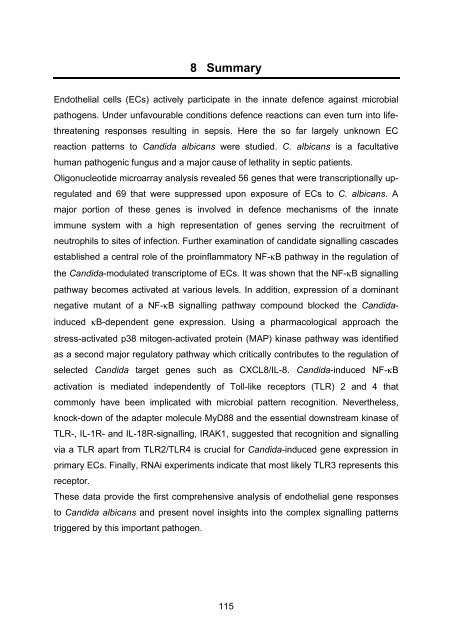Candida albicans-induzierte Genexpression in primären ... - OPUS
Candida albicans-induzierte Genexpression in primären ... - OPUS
Candida albicans-induzierte Genexpression in primären ... - OPUS
Sie wollen auch ein ePaper? Erhöhen Sie die Reichweite Ihrer Titel.
YUMPU macht aus Druck-PDFs automatisch weboptimierte ePaper, die Google liebt.
8 Summary<br />
Endothelial cells (ECs) actively participate <strong>in</strong> the <strong>in</strong>nate defence aga<strong>in</strong>st microbial<br />
pathogens. Under unfavourable conditions defence reactions can even turn <strong>in</strong>to lifethreaten<strong>in</strong>g<br />
responses result<strong>in</strong>g <strong>in</strong> sepsis. Here the so far largely unknown EC<br />
reaction patterns to <strong>Candida</strong> <strong>albicans</strong> were studied. C. <strong>albicans</strong> is a facultative<br />
human pathogenic fungus and a major cause of lethality <strong>in</strong> septic patients.<br />
Oligonucleotide microarray analysis revealed 56 genes that were transcriptionally upregulated<br />
and 69 that were suppressed upon exposure of ECs to C. <strong>albicans</strong>. A<br />
major portion of these genes is <strong>in</strong>volved <strong>in</strong> defence mechanisms of the <strong>in</strong>nate<br />
immune system with a high representation of genes serv<strong>in</strong>g the recruitment of<br />
neutrophils to sites of <strong>in</strong>fection. Further exam<strong>in</strong>ation of candidate signall<strong>in</strong>g cascades<br />
established a central role of the pro<strong>in</strong>flammatory NF-κB pathway <strong>in</strong> the regulation of<br />
the <strong>Candida</strong>-modulated transcriptome of ECs. It was shown that the NF-κB signall<strong>in</strong>g<br />
pathway becomes activated at various levels. In addition, expression of a dom<strong>in</strong>ant<br />
negative mutant of a NF-κB signall<strong>in</strong>g pathway compound blocked the <strong>Candida</strong><strong>in</strong>duced<br />
κB-dependent gene expression. Us<strong>in</strong>g a pharmacological approach the<br />
stress-activated p38 mitogen-activated prote<strong>in</strong> (MAP) k<strong>in</strong>ase pathway was identified<br />
as a second major regulatory pathway which critically contributes to the regulation of<br />
selected <strong>Candida</strong> target genes such as CXCL8/IL-8. <strong>Candida</strong>-<strong>in</strong>duced NF-κB<br />
activation is mediated <strong>in</strong>dependently of Toll-like receptors (TLR) 2 and 4 that<br />
commonly have been implicated with microbial pattern recognition. Nevertheless,<br />
knock-down of the adapter molecule MyD88 and the essential downstream k<strong>in</strong>ase of<br />
TLR-, IL-1R- and IL-18R-signall<strong>in</strong>g, IRAK1, suggested that recognition and signall<strong>in</strong>g<br />
via a TLR apart from TLR2/TLR4 is crucial for <strong>Candida</strong>-<strong>in</strong>duced gene expression <strong>in</strong><br />
primary ECs. F<strong>in</strong>ally, RNAi experiments <strong>in</strong>dicate that most likely TLR3 represents this<br />
receptor.<br />
These data provide the first comprehensive analysis of endothelial gene responses<br />
to <strong>Candida</strong> <strong>albicans</strong> and present novel <strong>in</strong>sights <strong>in</strong>to the complex signall<strong>in</strong>g patterns<br />
triggered by this important pathogen.<br />
115

















